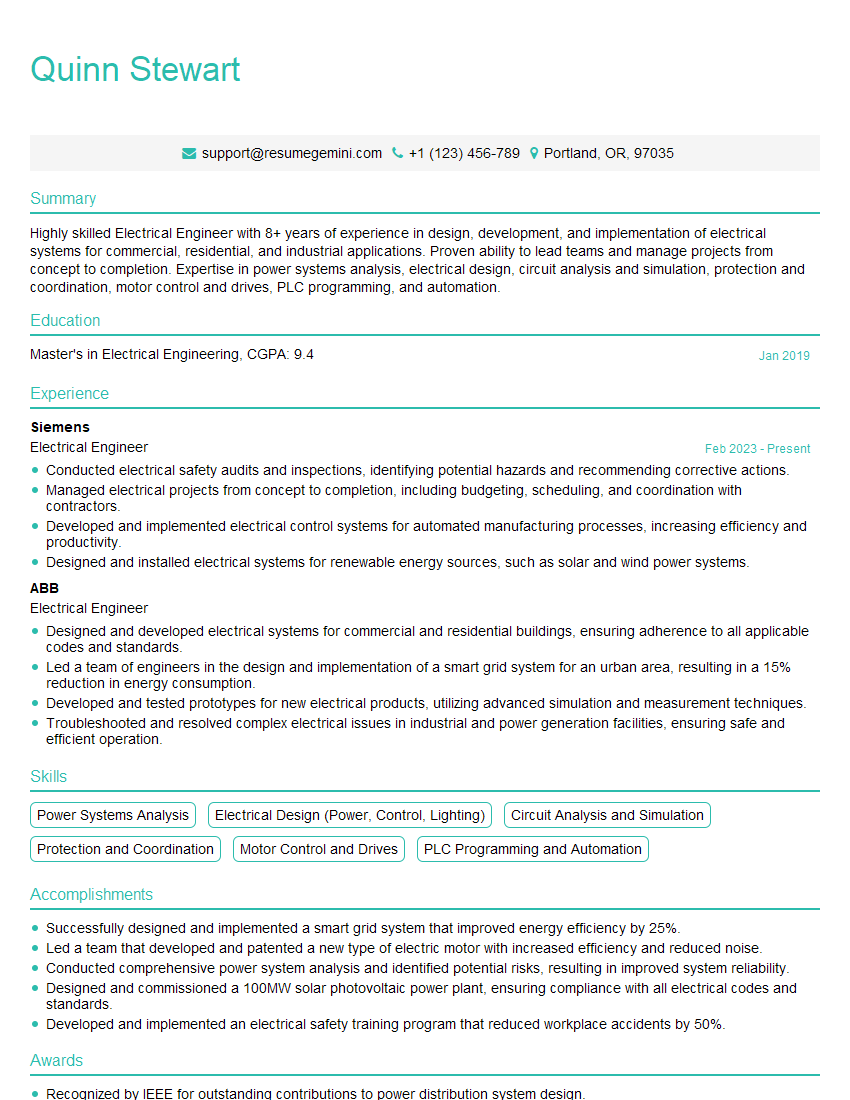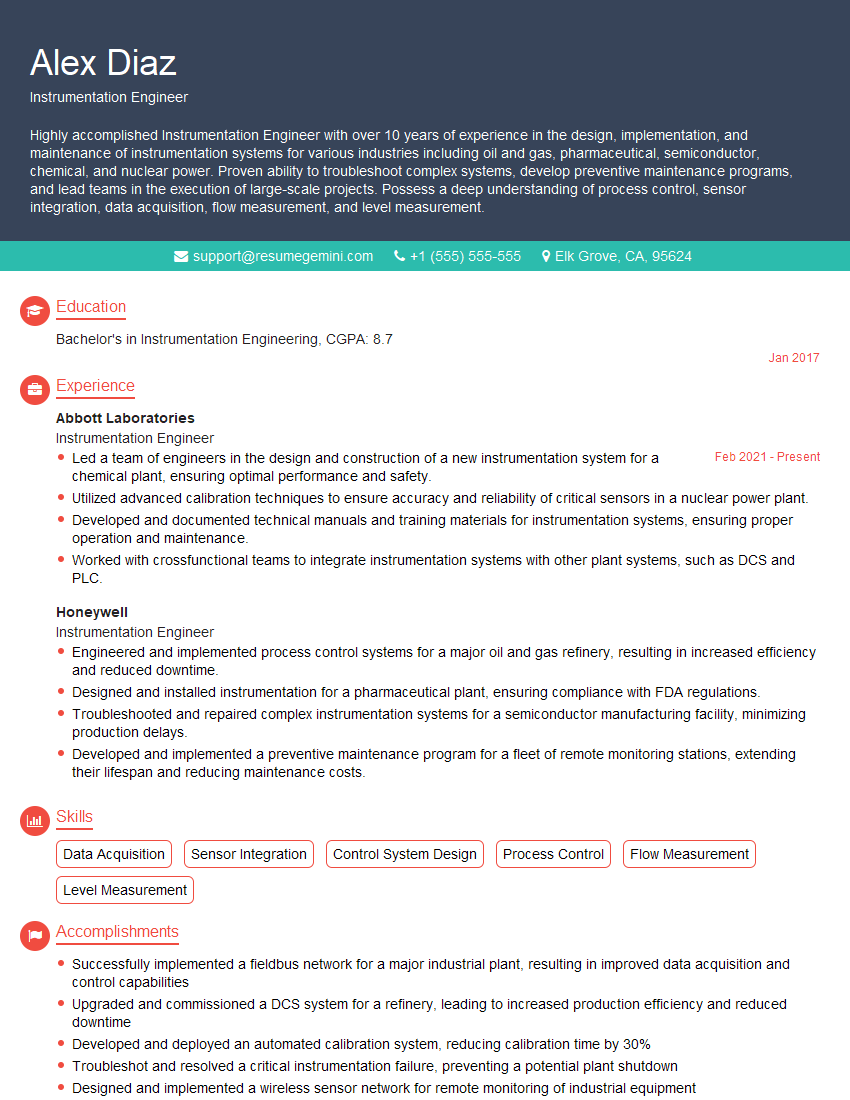Feeling uncertain about what to expect in your upcoming interview? We’ve got you covered! This blog highlights the most important Electrical Circuits interview questions and provides actionable advice to help you stand out as the ideal candidate. Let’s pave the way for your success.
Questions Asked in Electrical Circuits Interview
Q 1. Explain Kirchhoff’s Current Law (KCL) and Kirchhoff’s Voltage Law (KVL).
Kirchhoff’s laws are fundamental principles governing the behavior of electrical circuits. Kirchhoff’s Current Law (KCL) states that the algebraic sum of currents entering any node (junction) in a circuit is zero. Think of it like a water pipe junction – the total amount of water flowing in must equal the total amount flowing out. No water magically appears or disappears. Similarly, KCL ensures charge conservation.
Kirchhoff’s Voltage Law (KVL) states that the algebraic sum of voltages around any closed loop in a circuit is zero. Imagine walking around a closed circuit path; the total increase in potential (voltage rises from sources) must equal the total decrease in potential (voltage drops across components). It’s like climbing a hill and then descending the same amount, ending at the same elevation. Both laws are crucial for analyzing complex circuits.
Example: Consider a simple node with three currents: I1, I2, and I3. According to KCL: I1 + I2 – I3 = 0. If I1 = 2A and I2 = 3A, then I3 must be 5A. For KVL, in a loop with a 10V battery and a 5Ω resistor with 5A current, the voltage across the resistor (V=IR = 5Ω * 5A = 25V) opposes the battery’s voltage, making the sum zero: 10V – 25V = -15V (the negative sign indicates a counterclockwise loop direction).
Q 2. What are the different types of circuit analysis techniques?
Several circuit analysis techniques help us solve for voltages and currents in circuits. These include:
- Node Voltage Analysis (NVA): This method uses KCL at each node to determine node voltages. It’s particularly efficient for circuits with many nodes.
- Mesh Current Analysis (MCA): This uses KVL around each mesh (loop) in the circuit to determine mesh currents. It’s best suited for circuits with many loops.
- Superposition Theorem: This helps analyze circuits with multiple sources by considering the effect of each source individually and then summing the results.
- Thevenin’s Theorem: This simplifies a complex circuit into an equivalent circuit with a single voltage source and a single resistor, making calculations much easier.
- Norton’s Theorem: Similar to Thevenin’s, this simplifies a circuit to an equivalent circuit with a single current source and a single resistor.
The choice of method depends on the circuit’s topology and complexity. For instance, a circuit with many nodes may be better analyzed using NVA, while one with multiple loops might be more efficiently solved with MCA.
Q 3. Describe the operation of a simple RC circuit.
A simple RC circuit consists of a resistor (R) and a capacitor (C) connected in series or parallel with a voltage source. Let’s focus on the series case. When the source voltage is applied, the capacitor initially acts like a short circuit (allowing maximum current), and charges up exponentially. The charging process involves electrons accumulating on one capacitor plate and being depleted from the other. This charging current decreases over time as the capacitor’s voltage increases towards the source voltage. Once the capacitor is fully charged, no more current flows. If the source is then removed and the capacitor’s terminals are connected (discharged), current flows back through the resistor, and the capacitor discharges exponentially.
Q 4. How do you calculate the time constant of an RC circuit?
The time constant (τ) of an RC circuit is a measure of how quickly the capacitor charges or discharges. It’s defined as the product of the resistance (R) and the capacitance (C):
τ = R * C
The time constant represents the time it takes for the capacitor voltage to reach approximately 63.2% of its final value during charging or to drop to approximately 36.8% of its initial value during discharging. For instance, if an RC circuit has R = 1 kΩ and C = 1 μF, its time constant is 1 ms (millisecond). This means the capacitor’s voltage changes significantly within a few milliseconds.
Q 5. Explain the concept of impedance in AC circuits.
In AC circuits, impedance (Z) is the general term that describes the opposition to the flow of current. Unlike DC circuits where resistance is the only opposition, impedance in AC circuits includes both resistance and reactance. Reactance arises from the energy storage elements, inductors (L) and capacitors (C). Inductive reactance (XL = 2πfL) is proportional to frequency and inductance, while capacitive reactance (XC = 1/(2πfC)) is inversely proportional to frequency and capacitance.
Impedance is a complex number, represented as Z = R + jX, where R is resistance, X is reactance (XL – XC), and j is the imaginary unit. The magnitude of impedance, |Z| = √(R² + X²), determines the overall opposition to current flow.
Q 6. What is resonance in an RLC circuit?
Resonance in an RLC circuit occurs when the inductive reactance (XL) and capacitive reactance (XC) are equal in magnitude but opposite in sign. At resonance, the impedance is purely resistive (Z = R), meaning the circuit presents minimal opposition to current flow at a specific frequency. The energy stored in the inductor and capacitor oscillates between them, resulting in a large current flow for a given voltage.
Think of it like pushing a child on a swing. If you push at the right frequency (resonant frequency), the swing will move with maximum amplitude. If you push at a different frequency, the swing’s amplitude will be smaller.
Q 7. How do you determine the resonant frequency of an RLC circuit?
The resonant frequency (fr) of an RLC circuit is determined by the inductance (L) and capacitance (C) and can be calculated using the following formula:
fr = 1 / (2π√(LC))
At this frequency, the inductive and capacitive reactances cancel each other out, leading to resonance. The resistance (R) affects the sharpness of the resonance but doesn’t change the resonant frequency itself. For example, an RLC circuit with L = 10 mH and C = 100 nF would have a resonant frequency of approximately 15.9 kHz.
Q 8. Explain the difference between series and parallel resonant circuits.
Series and parallel resonant circuits are both types of RLC circuits (circuits containing resistors, inductors, and capacitors) that exhibit resonance, meaning they have a specific frequency at which their impedance is minimized (for parallel) or maximized (for series). The key difference lies in how the components are arranged and the resulting behavior at resonance.
In a series resonant circuit, the resistor, inductor, and capacitor are connected in series. At resonance, the inductive reactance (XL) and capacitive reactance (XC) cancel each other out (XL = XC), leaving only the resistance. This results in a minimum impedance and maximum current at the resonant frequency. Think of it like a highway with minimal traffic resistance – current flows freely. The resonant frequency (fr) is calculated as fr = 1 / (2π√(LC)).
A parallel resonant circuit, on the other hand, has the R, L, and C components connected in parallel. At resonance, the parallel combination of L and C exhibits maximum impedance. This is because the branch currents through the inductor and capacitor are equal in magnitude but 180 degrees out of phase, effectively canceling each other. The total current drawn from the source is at a minimum. Imagine this as a heavily congested intersection – the total flow of traffic is minimal despite individual vehicle movements. The resonant frequency is also calculated as fr = 1 / (2π√(LC)), but the behavior at resonance is opposite to the series circuit.
In practical applications, series resonant circuits are used in applications requiring a sharp peak in current at a specific frequency, like radio tuning circuits. Parallel resonant circuits, on the other hand, are often used in filter applications where high impedance at a specific frequency is desired.
Q 9. What are filters, and what are their applications?
Filters are circuits that allow specific frequencies to pass through while attenuating others. They’re fundamental to signal processing and are essential for isolating or removing unwanted signals or noise. Think of them as sieves for electrical signals, only letting certain frequencies pass through.
Applications are incredibly diverse. In audio systems, filters shape the sound by boosting or cutting specific frequencies (bass boost, treble cut). In communication systems, filters prevent interference between different channels. In power electronics, filters remove high-frequency noise from power supplies. Medical equipment uses filters to extract desired signals from noisy biological signals such as ECGs. Essentially, anywhere you need to control which frequencies are present in a signal, a filter is crucial.
Q 10. Describe different types of filters (low-pass, high-pass, band-pass, band-stop).
There are four main types of filters categorized by their frequency response:
- Low-pass filters: These allow low-frequency signals to pass through while attenuating high-frequency signals. Imagine a filter that only lets slow-moving cars pass; fast cars are blocked. Examples include smoothing circuits in power supplies.
- High-pass filters: These are the opposite; they let high-frequency signals pass while attenuating low-frequency signals. This would be like a filter that only allows fast cars to pass, blocking slow cars. They’re used to remove DC offsets from signals.
- Band-pass filters: These allow a specific range of frequencies to pass through, attenuating signals both below and above that range. This is like a toll booth that only lets cars within a specific speed range pass. They are used in radio receivers to select a specific station.
- Band-stop filters (or notch filters): These attenuate a specific range of frequencies while allowing signals both below and above that range to pass. This is similar to a roadblock that stops cars within a specific speed range. They’re used to remove interference from a specific frequency, such as 60 Hz hum in a power supply.
Q 11. Explain the operation of an operational amplifier (op-amp).
An operational amplifier (op-amp) is a high-gain DC-coupled amplifier with two input terminals (inverting and non-inverting) and one output terminal. At its core, it amplifies the difference between the voltages at its two input terminals. The op-amp’s high gain and differential input allow it to be used in a wide variety of applications, forming the basis of many analog circuits.
It works by comparing the voltages at the inverting (-) and non-inverting (+) terminals. If the voltage at the non-inverting terminal is higher, the output voltage will be positive; if it’s lower, the output will be negative. This difference is multiplied by the op-amp’s open-loop gain (which is typically very high), producing the output voltage. However, op-amps are rarely used in open-loop configurations due to sensitivity to input variations; negative feedback is usually employed for stability and precise control.
Q 12. What are the ideal characteristics of an op-amp?
Ideally, an op-amp exhibits several characteristics:
- Infinite open-loop gain: This means an infinitesimally small difference between input voltages would produce a large output voltage. This characteristic is crucial for achieving high precision.
- Infinite input impedance: This implies it draws no current from the input source, ensuring that the input signal is not loaded down by the op-amp.
- Zero output impedance: This means it can drive any load without affecting the output voltage, ensuring consistent signal delivery.
- Zero input offset voltage: This means there is no output voltage when the input voltages are equal; the output remains precisely zero.
- Infinite bandwidth: The op-amp can amplify signals of any frequency without any attenuation.
In reality, these are ideals that are closely approximated, but not perfectly achieved by real op-amps.
Q 13. Describe different op-amp configurations (inverting, non-inverting, summing, etc.).
Op-amps can be configured in various ways, each serving a specific purpose:
- Inverting amplifier: The input signal is applied to the inverting terminal, and the output is an amplified and inverted version of the input. The gain is determined by the ratio of feedback resistor (Rf) to input resistor (Ri).
Gain = -Rf/Ri - Non-inverting amplifier: The input signal is applied to the non-inverting terminal, and the output is an amplified and non-inverted version of the input. The gain is given by
Gain = 1 + (Rf/Ri). - Summing amplifier: Multiple input signals are summed together, with each input weighted by a corresponding resistor. The output is the amplified sum of the inputs.
- Difference amplifier (or subtractor): This configuration amplifies the difference between two input signals.
- Integrator: This configuration integrates the input signal over time. A capacitor is used in the feedback path.
- Differentiator: This configuration differentiates the input signal with respect to time. A capacitor is used in the input path.
These are just a few basic configurations; many more complex circuits can be built using op-amps.
Q 14. Explain the concept of negative feedback in op-amp circuits.
Negative feedback is a crucial concept in op-amp circuits. It involves feeding a portion of the output signal back to the inverting input terminal. This feedback reduces the overall gain of the amplifier but dramatically improves its stability and reduces its sensitivity to variations in component values or temperature.
The feedback loop creates a closed-loop system, where the output is constantly monitored and adjusted to maintain a desired output voltage. This leads to better linearity, reduced distortion, and predictable behavior. Think of it as a self-correcting mechanism. If the output deviates from the desired value, the negative feedback loop automatically corrects it, creating a stable and predictable circuit. Without negative feedback, op-amp circuits would be prone to oscillation and unpredictable behavior because of their high open-loop gain.
Q 15. What are the different types of transistors (BJT, MOSFET)?
Transistors are the fundamental building blocks of modern electronics, acting as electronic switches and amplifiers. The two main types are Bipolar Junction Transistors (BJTs) and Metal-Oxide-Semiconductor Field-Effect Transistors (MOSFETs). They differ significantly in their construction and operation.
- Bipolar Junction Transistors (BJTs): BJTs are current-controlled devices. Their operation relies on the flow of current through two junctions between differently doped semiconductor materials (typically silicon).
- Metal-Oxide-Semiconductor Field-Effect Transistors (MOSFETs): MOSFETs are voltage-controlled devices. Their operation depends on an electric field created by a voltage applied to a gate terminal, controlling the flow of current between the source and drain terminals.
The choice between a BJT and a MOSFET depends on the specific application, considering factors like power efficiency, switching speed, and integration density. MOSFETs are generally preferred in integrated circuits due to their higher integration density and lower power consumption, while BJTs can be advantageous in some high-power applications.
Career Expert Tips:
- Ace those interviews! Prepare effectively by reviewing the Top 50 Most Common Interview Questions on ResumeGemini.
- Navigate your job search with confidence! Explore a wide range of Career Tips on ResumeGemini. Learn about common challenges and recommendations to overcome them.
- Craft the perfect resume! Master the Art of Resume Writing with ResumeGemini’s guide. Showcase your unique qualifications and achievements effectively.
- Don’t miss out on holiday savings! Build your dream resume with ResumeGemini’s ATS optimized templates.
Q 16. Explain the characteristics of a BJT transistor.
BJTs are three-terminal devices with a base (B), collector (C), and emitter (E). Their operation hinges on the injection of minority carriers into the base region. Think of it like a faucet: a small current at the base controls a much larger current flowing between the collector and emitter.
- Current Controlled: A small base current controls a larger collector current. This provides amplification capabilities.
- Three Terminals: Base, Collector, and Emitter.
- Two Types (NPN and PNP): NPN transistors conduct when the base is positive relative to the emitter, while PNP transistors conduct when the base is negative relative to the emitter.
- Current Gain (β or hFE): This parameter describes the amplification factor – the ratio of collector current to base current.
- High Power Dissipation (in some configurations): BJTs can handle significant power levels, making them suitable for power amplifiers.
A common analogy is a water valve: a small turn of the valve (base current) controls a large flow of water (collector current).
Q 17. Explain the characteristics of a MOSFET transistor.
MOSFETs, unlike BJTs, are voltage-controlled devices with three terminals: gate (G), source (S), and drain (D). The gate is insulated from the channel, requiring only a small amount of current to control a larger current flowing between the source and drain.
- Voltage Controlled: A voltage applied to the gate controls the current flow between the source and drain. This leads to higher input impedance compared to BJTs.
- Three Terminals: Gate, Source, and Drain.
- Two Types (n-channel and p-channel): n-channel MOSFETs conduct when the gate voltage is positive relative to the source, and p-channel MOSFETs conduct when the gate voltage is negative relative to the source.
- Higher Input Impedance: MOSFETs have a very high input impedance, meaning they draw very little current from the input signal.
- Lower Power Consumption: Generally consume less power than BJTs, especially in standby mode.
Imagine a water gate: the height of the gate (gate voltage) determines how much water flows through (drain current).
Q 18. Describe different transistor biasing configurations.
Transistor biasing is crucial for setting the operating point of the transistor, ensuring it functions correctly within its desired range. Incorrect biasing can lead to distortion or device failure. Common biasing configurations include:
- Fixed Bias: A simple configuration using resistors to set the base current. It’s susceptible to variations in transistor parameters, making it less stable.
- Self-Bias (Emitter Bias): Improves stability compared to fixed bias by using negative feedback from the emitter resistor.
- Voltage Divider Bias: Provides good stability and is widely used due to its relatively constant operating point.
- Collector Feedback Bias: Another stable configuration, simpler than voltage divider bias, but with slightly less stable operating point.
The choice of configuration depends on the specific application requirements, considering factors such as stability, simplicity, and power consumption. Detailed analysis including DC and AC load lines is vital for optimal design.
Q 19. What are logic gates, and how do they function?
Logic gates are the fundamental building blocks of digital circuits. They perform logical operations on one or more binary inputs (0 or 1, representing low or high voltage levels) to produce a single binary output. These operations underpin all digital computations and data processing in computers and other digital systems.
Think of them as electronic switches that follow specific rules to determine the output based on the input states. These rules are defined by Boolean algebra.
Q 20. Explain the operation of different logic gates (AND, OR, NOT, NAND, NOR, XOR, XNOR).
Each logic gate performs a specific Boolean operation:
- AND Gate: Output is 1 only if all inputs are 1.
A AND B = 1only ifA = 1andB = 1. - OR Gate: Output is 1 if at least one input is 1.
A OR B = 1ifA = 1orB = 1or both. - NOT Gate (Inverter): Output is the inverse of the input.
NOT A = 1ifA = 0, and vice versa. - NAND Gate: Output is the inverse of an AND gate.
A NAND B = 0only ifA = 1andB = 1. - NOR Gate: Output is the inverse of an OR gate.
A NOR B = 0ifA = 1orB = 1or both. - XOR Gate (Exclusive OR): Output is 1 if only one input is 1.
A XOR B = 1ifA = 1andB = 0, or ifA = 0andB = 1. - XNOR Gate (Exclusive NOR): Output is the inverse of an XOR gate.
These gates can be combined to create complex digital circuits capable of performing a vast array of functions.
Q 21. What is Boolean algebra, and how is it used in digital circuit design?
Boolean algebra is a mathematical system that deals with variables that can have only two values: 0 and 1 (representing FALSE and TRUE, respectively). It provides a framework for representing and manipulating logical expressions using operators like AND, OR, and NOT. This is fundamental to digital circuit design because it allows us to:
- Design Logic Circuits: Use Boolean expressions to describe the desired logic function of a circuit.
- Simplify Logic Expressions: Employ Boolean theorems to minimize the number of gates needed, simplifying the circuit and reducing cost and power consumption.
- Analyze Logic Circuits: Verify the correct functionality of a designed circuit through Boolean analysis.
For example, a Boolean expression like Y = A AND (B OR C) can directly translate to a logic circuit using AND and OR gates. Boolean algebra provides the tools for simplifying such expressions, potentially eliminating unnecessary gates and improving circuit efficiency.
Q 22. Explain the concept of a Karnaugh map (K-map).
A Karnaugh map (K-map) is a graphical method used to simplify Boolean algebra expressions. It’s particularly useful for minimizing logic functions with up to four or five variables, making it easier to design simpler and more efficient digital circuits. Imagine it as a visual tool that helps you spot patterns and redundancies in your logic, allowing you to eliminate unnecessary gates and reduce complexity.
A K-map arranges the minterms (or maxterms) of a Boolean function in a grid. The arrangement ensures that adjacent cells differ by only one variable. This adjacency allows you to easily group minterms (1s) together to form larger blocks of powers of two (2, 4, 8, etc.). Each block represents a simplified product term. Grouping these blocks minimizes the number of terms in the final expression, leading to a more economical circuit implementation.
Example: Consider a function with three variables (A, B, C). The K-map would be a 2×4 grid. By grouping adjacent 1s, we can identify common factors and simplify the function. For instance, if we have 1s in cells representing AB’C, ABC, A’BC, and A’B’C, these can be grouped into a larger block representing the simplified term ‘C’.
Q 23. How do you design a simple combinational circuit?
Designing a simple combinational circuit involves a few key steps. A combinational circuit’s output depends solely on its current inputs; there’s no memory or feedback. Think of a simple light switch: the light is on only when the switch is on.
- 1. Define the problem: Clearly specify the desired input-output relationship. What are the inputs, and what output is expected for each combination of inputs?
- 2. Create a truth table: List all possible input combinations and the corresponding output for each. This provides a complete specification of the circuit’s behavior.
- 3. Simplify the Boolean expression: Using Boolean algebra, K-maps, or other minimization techniques, simplify the truth table’s logic to reduce the number of gates needed. This optimizes cost and complexity.
- 4. Draw the logic diagram: Using standard logic gates (AND, OR, NOT, XOR, etc.), draw a schematic diagram representing the simplified Boolean expression. This forms the circuit design.
- 5. Verify the design: Simulate the circuit using software (like LogicWorks or Multisim) or build it physically to verify that it behaves as expected.
Example: A half-adder circuit takes two binary inputs and produces a sum and a carry output. The truth table, Boolean expressions, and logic diagram can all be derived systematically, leading to a minimal implementation using only AND, XOR, and OR gates.
Q 24. How do you design a simple sequential circuit?
Designing a sequential circuit is more complex than combinational because the output depends not only on the current inputs but also on the past history of inputs (the circuit’s state). Think of a light switch with a timer; its behavior depends on both the switch’s current position and how long it’s been in that position.
- 1. State Diagram: This visually represents the different states the circuit can be in and the transitions between them, based on the inputs. Each state represents a memory configuration.
- 2. State Table: This table lists all states, the inputs, the next state, and the output for each combination. It’s a more structured representation of the state diagram.
- 3. State Assignment: Assign binary codes to each state. This is crucial for implementing the circuit using flip-flops.
- 4. Flip-flop selection: Choose appropriate flip-flops (D, JK, T, SR) to implement the state transitions. The choice depends on the complexity and the nature of the transitions.
- 5. Logic Circuit Design: Design the combinational logic to determine the next state and output based on the current state and input. This logic is often simplified using K-maps.
- 6. Verification: Simulate or physically build the circuit to confirm its correct operation.
Example: A simple counter circuit can be designed using flip-flops to sequence through states, representing the count. A sequence detector identifies specific input patterns.
Q 25. What is a flip-flop, and what are its applications?
A flip-flop is a fundamental building block of sequential circuits. It’s essentially a one-bit memory element that can store a binary value (0 or 1). Think of it as a tiny electronic switch that can ‘remember’ its state even when the input changes. This memory capability is essential for sequential logic.
Applications: Flip-flops are widely used in:
- Counters: To increment or decrement values.
- Registers: To store binary data.
- Shift registers: To shift data bits left or right.
- Memory: As basic storage elements in larger memory systems.
- Sequence detectors: Identifying specific patterns in input sequences.
Q 26. Describe different types of flip-flops (D, JK, T, SR).
Several types of flip-flops exist, each with its unique characteristics and applications:
- D Flip-flop (Data): The output (Q) follows the input (D) when a clock pulse arrives. It’s the simplest and most commonly used flip-flop.
- JK Flip-flop: More versatile than the D flip-flop, offering four modes of operation: toggle, set, reset, and hold, controlled by the J and K inputs. It can be used to build counters and other sequential circuits.
- T Flip-flop (Toggle): The output toggles (changes state) on each clock pulse if the T input is high (1), essentially a JK flip-flop with J=K=1.
- SR Flip-flop (Set-Reset): It has two inputs: S (Set) and R (Reset). S=1 sets the output to 1, R=1 resets it to 0. S=R=1 is usually an invalid state.
Each flip-flop type has its strengths and weaknesses. The choice depends on the specific requirements of the application. For instance, if you simply need to latch data, a D flip-flop is sufficient. If you need more flexible behavior, like toggling or counting, a JK or T flip-flop might be preferable.
Q 27. Explain the concept of power factor correction.
Power factor correction (PFC) aims to improve the power factor of an AC circuit. The power factor represents the efficiency of electrical power usage. A low power factor indicates that a significant portion of the current is not contributing to actual work but is instead circulating uselessly. This is often caused by inductive loads (like motors and transformers) which create a phase difference between voltage and current.
Improving the power factor reduces energy waste, minimizes current draw, and improves overall system efficiency. This is achieved by adding devices (capacitors or synchronous motors) that compensate for the reactive power, bringing the phase difference closer to zero and improving the power factor towards 1.
Benefits of PFC: Reduced electricity bills, smaller equipment ratings (as less current is required for the same power), improved voltage regulation, and reduced losses in the distribution system.
Q 28. How do you calculate the power factor in an AC circuit?
The power factor (PF) in an AC circuit is calculated as the cosine of the phase angle (θ) between the voltage and current waveforms. It’s a value between 0 and 1, representing the fraction of the apparent power that is actually doing useful work (real power).
Calculation:
- PF = cos(θ)
- θ = arctan(XL – XC) / R) where XL is inductive reactance, XC is capacitive reactance, and R is resistance.
- PF = Real Power / Apparent Power where real power (P) is measured in watts (W) and apparent power (S) is measured in volt-amperes (VA).
In simpler terms, if the voltage and current are in phase (θ = 0), the power factor is 1 (perfectly efficient). If they are significantly out of phase, the power factor will be lower, indicating less efficiency.
Measuring the real and apparent power directly using a power meter provides a straightforward method for calculating the power factor. If the circuit components (R, L, C) are known, it can also be calculated from the impedance.
Key Topics to Learn for Electrical Circuits Interview
- Circuit Analysis Techniques: Mastering nodal and mesh analysis, superposition, Thevenin and Norton theorems is crucial for understanding circuit behavior.
- AC and DC Circuit Analysis: Understand the differences and applications of both, including phasor analysis for AC circuits and transient response analysis.
- Network Theorems: Demonstrate a firm grasp of theorems like maximum power transfer and reciprocity, and their practical implications in circuit design.
- Passive Components: Thoroughly understand the behavior of resistors, capacitors, and inductors, both individually and in combination within circuits.
- Operational Amplifiers (Op-Amps): Familiarize yourself with the ideal op-amp model and its applications in various circuits, such as amplifiers and filters.
- Diodes and Transistors: Understand the characteristics and applications of these fundamental semiconductor devices in rectifiers, amplifiers, and switching circuits.
- Circuit Simulation Software: Show familiarity with tools like LTSpice or Multisim, highlighting your ability to model and analyze complex circuits.
- Signal and System Analysis: Demonstrate understanding of frequency response, Bode plots, and basic concepts of signal processing relevant to electrical circuits.
- Power Systems Basics: For roles involving power systems, have a foundational understanding of power generation, transmission, and distribution principles.
- Problem-Solving Approach: Practice breaking down complex circuits into simpler parts, applying relevant theorems, and clearly articulating your solution methodology.
Next Steps
Mastering Electrical Circuits is vital for a successful career in engineering, opening doors to diverse and challenging roles. A strong foundation in these concepts demonstrates your analytical skills and problem-solving capabilities, making you a highly desirable candidate. To maximize your job prospects, crafting a compelling and ATS-friendly resume is essential. ResumeGemini is a trusted resource to help you build a professional resume that highlights your skills and experience effectively. Examples of resumes tailored specifically for Electrical Circuits professionals are available to guide you. Invest time in perfecting your resume; it’s your first impression on potential employers.
Explore more articles
Users Rating of Our Blogs
Share Your Experience
We value your feedback! Please rate our content and share your thoughts (optional).
What Readers Say About Our Blog
Interesting Article, I liked the depth of knowledge you’ve shared.
Helpful, thanks for sharing.
Hi, I represent a social media marketing agency and liked your blog
Hi, I represent an SEO company that specialises in getting you AI citations and higher rankings on Google. I’d like to offer you a 100% free SEO audit for your website. Would you be interested?












